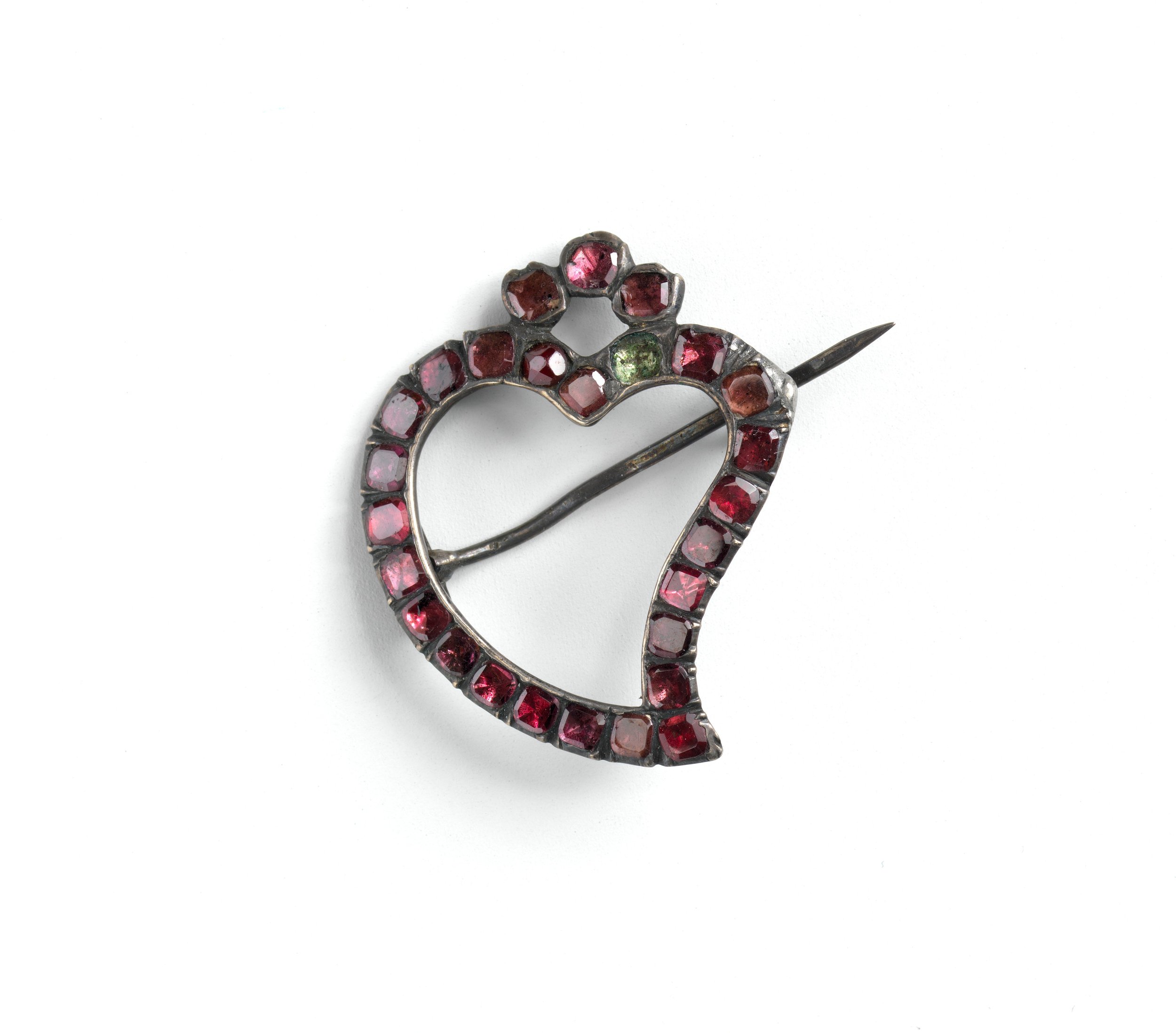“The jewelry of any era is indicative of the values held by the people of that time ”
For the month of February, we have a special Valentine’s Day Edition of Pride and Possibilities. Jane Austen Fan Fiction writer Heather Moll discusses jewelry that was popular during the Georgian era as well as pieces that would have been trendy during Jane Austen’s life.
Jane Austen’s letters are full of observations on fashion, and this includes jewelry. In her letter to Cassandra from May 26-27th, 1801, she mentions the topaz crosses given to them by their brother, second lieutenant Charles Austen. They were staying with their aunt and uncle in Bath when she wrote:
I give Charles great credit for remembering my Uncle’s direction, and he seems rather surprised at it himself. He has received 30£ for his share of the privateer and expects 10£ more—but of what avail is it to take prizes if he lays out the produce in presents to his Sisters. He has been buying Gold chains and Topaze Crosses for us; he must be well scolded.
She teases that she and Cassandra will be unbearably fine, but both necklaces survive and are on display at the Jane Austen House Museum. I suspect they treasured these gifts. A similar sentimental gift appears in William Price’s present of a cross to his sister Fanny in Mansfield Park, which Jane Austen describes as “the almost solitary ornament in her possession, a very pretty amber cross which William had brought her from Sicily.”
The jewelry of the eighteenth and early nineteenth century embodied the values of the time, especially sentiment, romance, and even a bit of intrigue. Styles from this long era range from dramatic and ornate to a simplicity that paralleled a similar shift in dress toward lighter and more refined lines. But symbolism and sentimentality played a role in many of the popular jewelry trends.
I write Jane Austen variations and feature a piece of Georgian jewelry in nearly every novel I write. These are a few that I’ve incorporated so far, or will be featured soon, and part of the reason I chose them is because their style especially fits the sentimental and romantic vibe I’m going for.
Posy rings were popular in the post-medieval period through the eighteenth century. They have a gold band with a short inscription on the inside. The name derives from the French word poésy—a short rhyme or poem—because these rings were engraved with a rhyming message. First on the outside, and then over time moving to the inside of the band and even losing the rhyme. They were a way to show regard for a spouse—or a lover on the side.
This piece from the British Museum is c. 17th-18th century and is inscribed with “In thee my choyes i doe reioyes,” loosely translating to “In thee my choice, I do rejoice.”
Georgian jewelry was often romantic, and heart brooches were common gifts for loved ones. One popular style was an open heart brooch called a witch’s heart. The tail of a witch’s heart twists to the right side and is a shape used since the 15th century. They gained popularity in Scotland in the 17th century when they were known as a Luckenbooth, named for the stalls in Edinburgh, where they were sold as tokens to ward off evil spirits and protect loved ones.
By the 18th century, the witch’s heart had taken on a meaning beyond a talisman—they were given to a loved one as proof of being “bewitched” with love. As love tokens used by the Georgians, they were most commonly made of garnets, symbols of love and friendship.
It makes me think of chapter ten in Pride and Prejudice when Darcy is falling in love with Elizabeth. “But there was a mixture of sweetness and archness in her manner which made it difficult for her to affront anybody, and Darcy had never been so bewitched by any woman as he was by her.”
This is a c. 1770 witch’s heart held by the Met.
Eye miniatures were a fad in Georgian England for a short time around the turn of the 19th century. They were popularized by the Prince of Wales and his infamous love affair with Maria Fitzherbert. He pursued her even though she was a Catholic widow and prohibited from becoming queen, and he sent her a small portrait of only his right eye in 1785. It must have been convincing because she agreed to marry him, even though their union was immediately void. In return, she had a similar eye miniature made for him.
Now known as lover’s eyes, they displayed one eye and sometimes an eyebrow and hair. Lover’s eyes could be ornate or simple, and were made into rings, lockets, pendants, and brooches. They were a discreet way to show admiration, love, or even lust. Only an intimate acquaintance—a lover, spouse, or family member—would recognize a single eye.
This eye brooch is c. early 19th century with pearls and is held by the Met.
Acrostic jewelry was popularized at the beginning of the nineteenth century and held a secret message. The first letter of each stone spells out a term of endearment or a romantic word. It’s believed they began in the late 18th century with Jean-Baptiste Mellerio, a jeweler to the French court, who used jewels spelling out “J’adore.” Napoleon Bonaparte became a fan of the style and had numerous acrostic pieces commissioned for both his wives.
Common words were “regard” and “adore.” A ruby, emerald, garnet, amethyst, ruby, and diamond would spell regard; adore would be spelled by an amethyst, diamond, opal, ruby, and emerald.
Padlocks and key pendants or brooches were common acrostic mementos, along with rings. Acrostics remained popular through the late Georgian and Victorian period.
Image by Heather Moll
This is my ring from the early Victorian period c. 1830-1850. It’s a “dearest” cluster ring.
These emotionally charged pieces were given as striking tokens of affection. Jewelry pieces like these often made it possible to display affection while concealing the identity of the lover. The jewelry of any era is indicative of the values held by the people of that time and the Georgian period was full of unabashed sentiment—think Marianne Dashwood’s sensibility. These styles of jewelry mentioned here were either still in place but less popular during Austen’s life or very trendy and likely to have been known by her. These pieces could be precious gestures of love and affection as seen through Charles’s Austen’s gifts to Jane and Cassandra.
© Heather Moll 2024. Heather Moll writes romantic variations of Jane Austen's classic novels. She found Jane Austen later than she should have and made up for lost time by devouring her letters and unpublished works, joining JASNA, and spending too much time researching the Regency era. She lives with her husband and son, and struggles to balance all the important things, like whether to buy groceries or stay home and write. You can find her at, https://www.heathermollauthor.com
Special Event - Saturday 17th February
You are ALL invited to join us for an enchanting hour filled with literary delight at our LOVE Books Tea Party, hosted by the Jane Austen Literacy Foundation Community, to celebrate the joy of reading and bring together a community of kindred spirits.
The event will stream free and live on Facebook and YouTube and we invite you to pour yourself a cup of your favourite tea, settle into your comfiest reading nook, and join our special guests for an hour of warmth, camaraderie, and bookish joy:
Works Cited:
Le Faye, D. (Ed.). (2011). Jane Austen’s Letters (4th ed.). Oxford University Press.
Austen, J. (1814). Mansfield Park. Thomas Egerton.
Austen, J. (1813). Pride and Prejudice. Thomas Egerton.
Daws, G and Olivia Collings. (2019). Georgian Jewellry. ACC Art Books.









